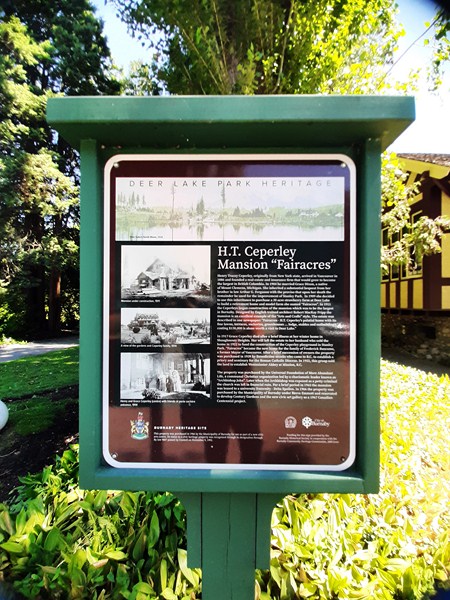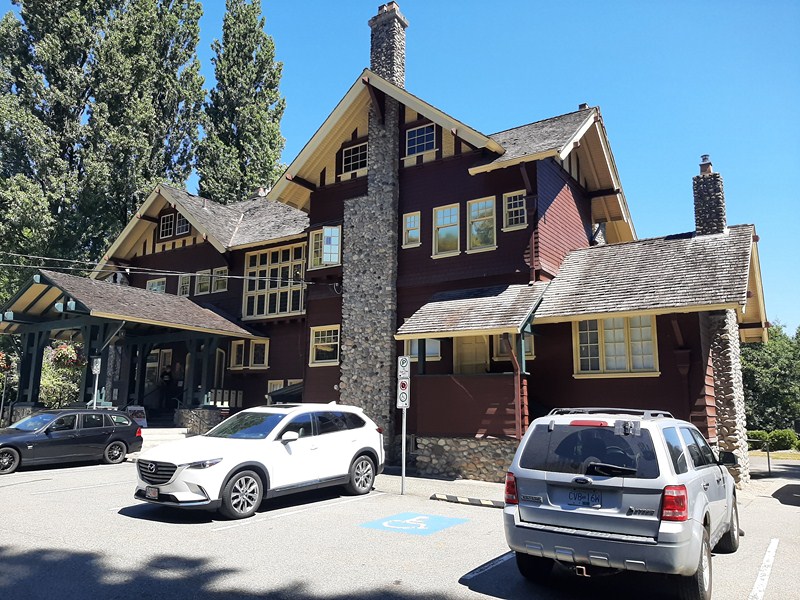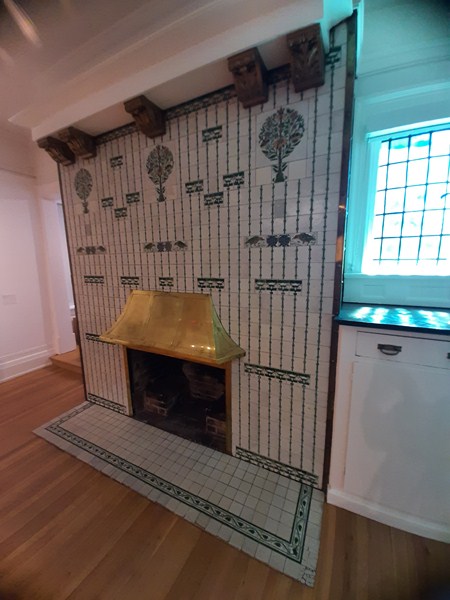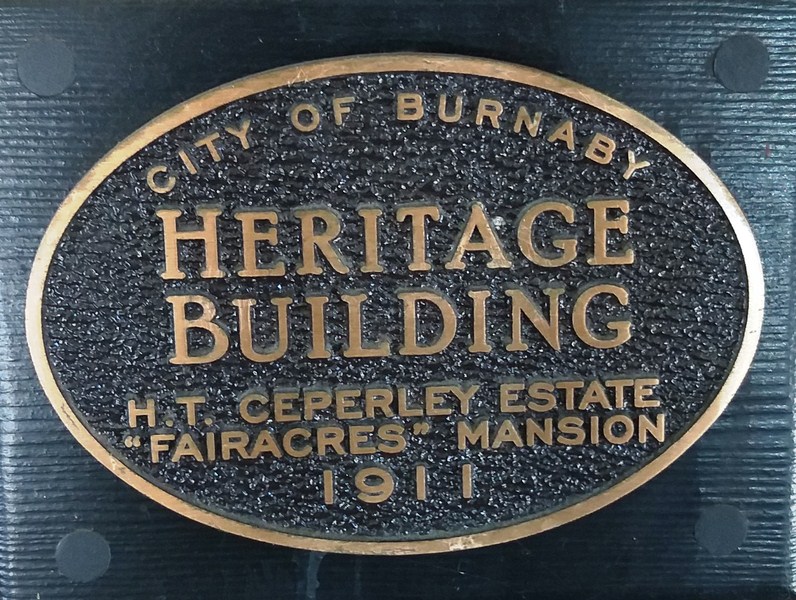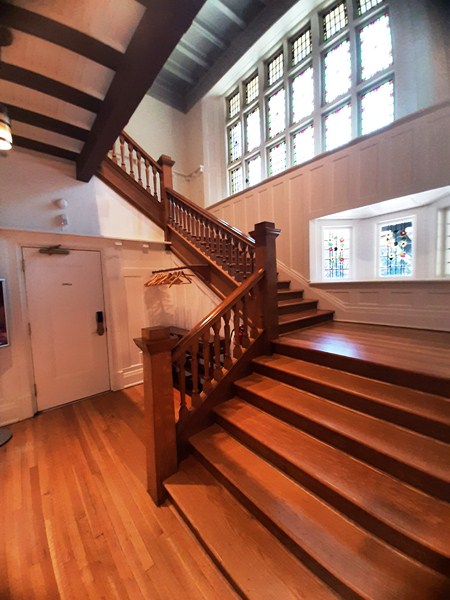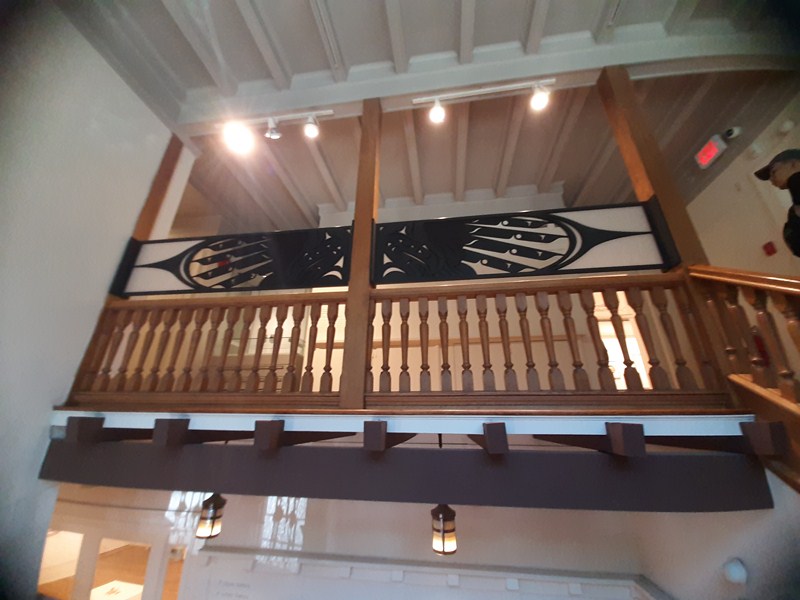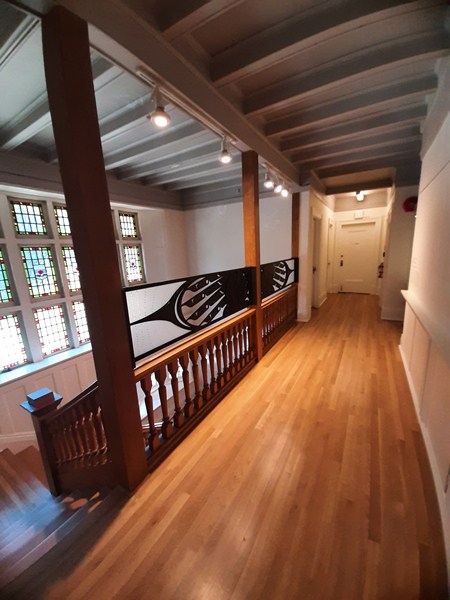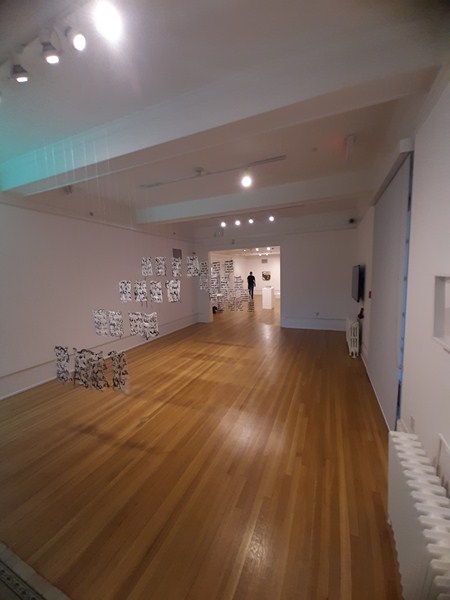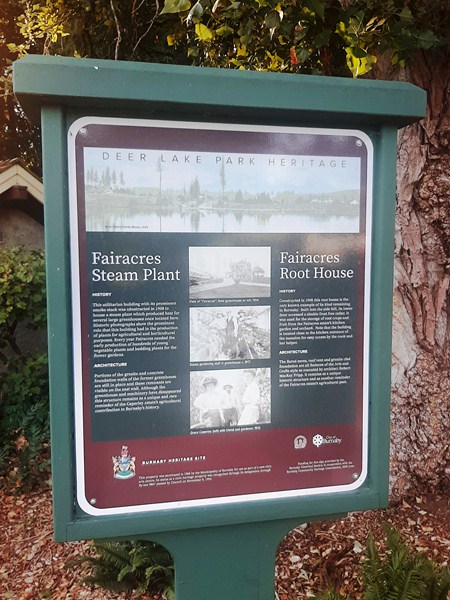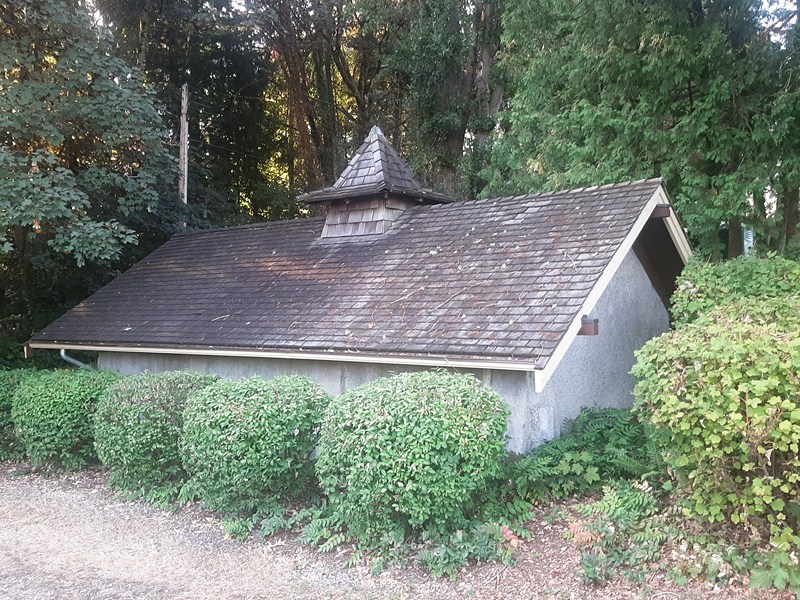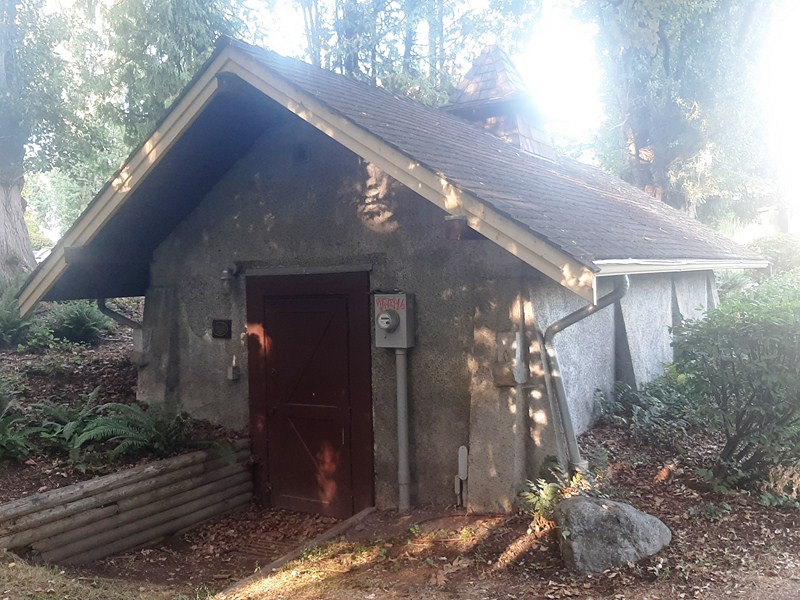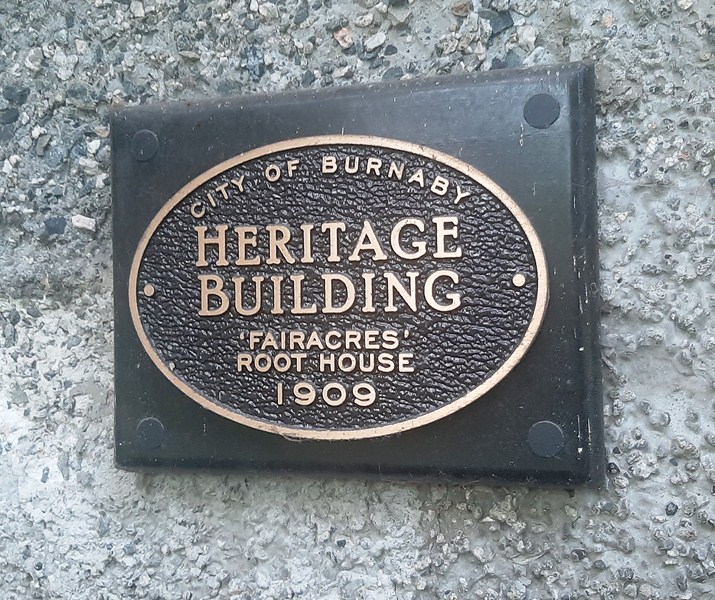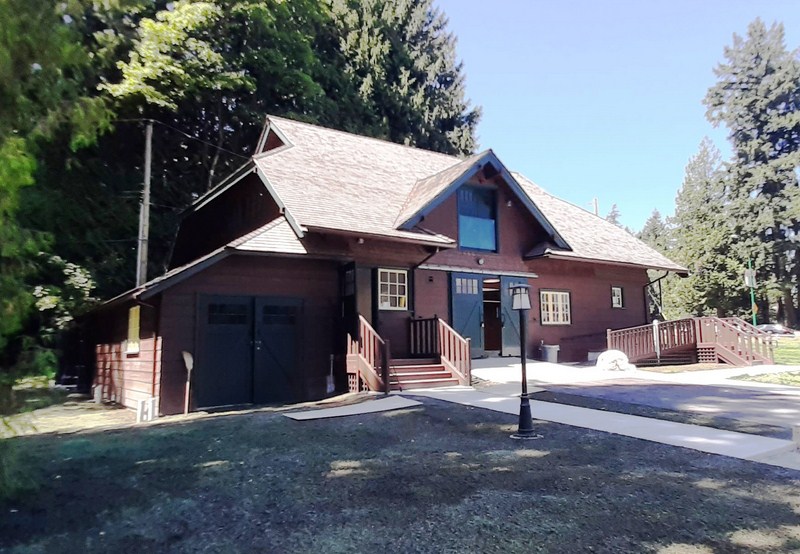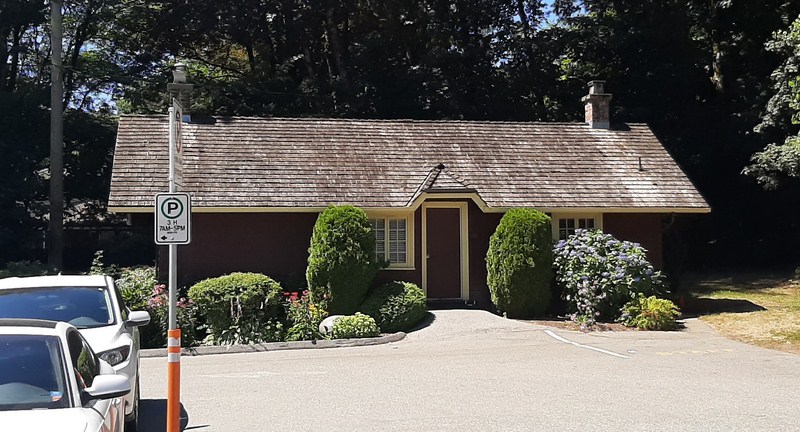The large, two-and-one-half storey, sprawling Fairacres Mansion, also called the H.T. Ceperley House (after its original owners), now houses the Burnaby Art Gallery. Designed by English born and trained architect Robert Percival Sterling Twizell (1875-1964) who was steeped in the current architectural trends in Great Britain, it was one of his grandest residential commissions. The mansion, on the north shore of Deer Lake, was built in 1910 at an estimated cost of C$150,000.00, making it the largest and most expensive house in Burnaby and the Lower Mainland at that time.
Check out “Burnaby Art Gallery” and “Deer Lake Park”
The 20-acre (half of it landscaping) estate, owned by American-born couple Henry Tracy Ceperley (1850- 1929) and Grace E. Dixon Ceperley (1863-1917, a successful and well-respected businessman who made a significant contribution to the development of the City of Vancouver), was conceived and funded by Grace who had achieved significant wealth through a bequest from Vancouver pioneer Arthur G. Ferguson (the same Ferguson of Ferguson Point in Stanley Park), her brother-in-law. The construction of Fairacres, their retirement home, spawned the transformation of the Deer Lake area from a farming community into a preferred location for elite suburban homes.

The mansion was constructed in the Edwardian Arts and Crafts style which is often used for estate mansions as a symbol of affluence and good, modern taste, as well as an affinity for all things British. It is reflected in the architectural detailing and proportions, with handmade fixtures, carpentry and tiled fireplaces. Quality, in the finishes and materials, orchestrated by James Charles Allen, a prominent local contractor, was displayed inside and out.
On the death of Grace at the age of 54 ‘(her ghost was said to haunt the mansion), Henry sold the house, in 1923, to Frederick Buscombe (one-time mayor of Vancouver). It also served as a tuberculosis ward for Vancouver General Hospital. In 1939, Mr. and Mrs. Alexander Munro, the last family to own the mansion, sold the house to the Benedictine monks from Oregon and, in 1953, it became an abbey. In 1954, the Order vacated the house when it moved to Westminster Abbey (British Columbia) in Mission.
In 1955, the Benedictines sold the property to the Canadian Temple of the More Abundant Life, a cult headed by William Franklin Wolsey (who called himself “Archbishop John I”), a convicted bigamist (with a string of extortion and wife-beating charges), serving as its church and school. After the school closed in 1960 (when Wolsey fled the country), it was leased and converted into a fraternity house (or “Animal House” of sorts) for Simon Fraser University‘s Delta Upsilon Fraternity.
In 1966, the Burnaby Art Society (led by Jack Hardman, Polly Svangtun, Sheila Kincaid and Winifred Denny, among others) worked with the City of Burnaby (its first civic heritage conservation project) to purchase the 3.4 hectares (8.4 acres) site for C$166,000.00 for conversion to Burnaby’s first art gallery.
To mark Canada’s Centennial of Confederation, the Burnaby Art Gallery opened its doors in June 1967. In 1992, it was designated as a Heritage Property and, on February 22, 2005, it was listed on the Canadian Register of Historic Places.
The exterior featured a rich variety of exterior elements that demonstrate the typical Edwardian Arts and Crafts use of local materials such as cobblestone chimneys and foundations, wide wooden siding and half-timbering.
It had a side-gabled roof with prominent dormers and cedar shingle cladding, a porte cochere (with its side steps for those arriving by automobile, and central raised step for those alighting from horse-drawn carriages), a mixture of double-hung and casement wooden-sash windows (many with multi-paned sash) and a verandah across the eastern (garden) facade, with its vistas over the landscaped gardens, the distant mountains, Deer Lake and other grand homes in the area.
The lavish interior spaces, designed for entertaining on a grand scale, featured a generous living and dining rooms arranged off a central hall. Detailed features of the interior woodwork (including the staircase) were carved by Scottish-born George Selkirk Gibson (1867-1942), a master wood carver who was best known for his many commissions for prominent British Columbia architect Samuel Maclure.
The billiard room and parlor with a beamed ceiling and an inglenook fireplace, also had a grand oak mantelpiece hand-carved by Gibson which bears a quote by Ralph Waldo Emerson: “The ornament of a house is the friends who frequent it.”
The tiles in the fireplace surrounds throughout the house, imported from England, were fabricated by Conrad Dressler and his Medmenham Pottery. It is one of the earliest documented use of these tiles outside the United Kingdom. The interiors also featured leaded stained glass and window hardware by Hope and Sons.
The main house anchors, in style and setting, the four associated original outbuildings (Garage and Stables; Root House, Steam Plant and Chauffeur’s Cottage) on the estate which are an important record of the functioning of a large estate of the time. Some were designed by Architect Robert Mackay Fripp (1858-1917), also an outspoken advocate of Arts and Crafts design.
The one-storey, 4.6 by 9.1 m., masonry Root House, was used as a frost-free store for fruit and vegetables for the family’s use. Built in 1908, the long, low Root House was significantly altered in the 1960s and restored to its original design in 2000.
It had a front-gabled roof with cedar shingle cladding and its distinctive Arts and Crafts architectural features include its original louvered ventilation cupola with flared roof, extended eaves and brackets, and pebble-dashed stucco coating on the concrete walls.
The Garage and Stables and the Chauffeur’s Cottage accommodated the use of automobiles, horses and carriages and, in concert with the estate’s location near the new British Columbia Electric Railway Burnaby Lake interurban line, illustrate the evolving nature of regional transportation and the growing bedroom communities and estates made possible by increasing options for transportation.
The two-storey, wood frame Garage and Stables, situated to the north of the Chauffeur’s Cottage, its distinctive Arts and Crafts architectural features include the shingle wall cladding articulated with a chevron-patterned course of shingles at the first floor level, multi-paned wooden-sash casement windows (some retaining original wired glass), and deep eaves with additional purlins to support the overhang. Its stable doors, with hand-made forged-iron door hardware, are still original.
The long, narrow single-storey Chauffeur’s Cottage, situated across from the main entrance to the Ceperley mansion, adjacent to the Garage and Stables, was constructed by joining together two modest estate cottages.
Its distinctive Arts and Crafts architectural features include the jerkin-headed door hood, a reference to the thatched-roofed cottages of southern England, eight-paned wooden-sash casement windows, and cedar-shingled exterior. The modest, functional interior, with simple trim and lack of pretension, had two internal brick chimneys.
The single-storey wood-frame Steam Plant building, built from 1907 to 1908, had a gabled roof that originally housed the apparatus for climate control in the greenhouse (formerly located to its north). It was significantly altered in the 1960s and restored to its original design in 2000.
Adjacent to it is the original rubblestone walls that formed the foundation for the greenhouse. It had six-paned wooden-sash casement windows and its distinctive Arts and Crafts architectural features include the shingle wall cladding with decorative shingling under window sills, deep eaves, and pebble-dashed concrete foundation walls.
The remaining formal Edwardian garden landscape elements include the cross-axial plan that reflects the relationship of the mansion to its outdoor rooms. Its grounds also included horse stables, an aviary, gazebo and pergola, lagoons, strawberry fields, greenhouses, a kiln station and a gardener’s cottage. On November 23, 1992, Fairacres Mansion was designated as a Heritage Site.
Check out “Heritage Buildings of Burnaby”
Fairacres Mansion: 6344 Deer Lake Ave., Burnaby V5G 213, British Columbia, Canada. Tel: (604) 297-4422. Fax: (604) 205-7339. E-mail: gallery@burnaby.ca. Website: www.burnabyartgallery.ca. Open Tuesdays to Fridays, 10 AM to 4:30 PM, and Saturdays and Sundays, 12 noon to 5 PM. Admission is free (a C$5 donation is suggested).
How to Get There: Bus 144 Metrotown runs from the Burnaby Lake SkyTrain Station to the mansion. By car, take Sprott St. Exit, drive straight through Canada Way, past Burnaby City Hall and Central High School, turn left into Deer Lake Ave. The mansion is at the top of the hill on your right.


